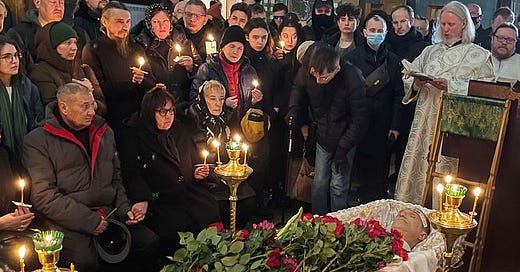Today, It's Navalny, Tomorrow It Could Be Anyone in Russia
The lifelessness of Navalny's face speaks for all of the country, but most are too cowardly to understand
When I first saw the body lying in the open casket, I thought of Vladimir Lenin, the founding revolutionary of the Soviet Union. Deep beneath the earth on Red Square, the brick and granite of the mausoleum are set off perfectly by the polished black marble. When you enter, you slowly cascade downwards to the waxy body. As eerie and somber as it is inside, it could also be the setting for a 1970s-Swedish porn.
Something else made me think of Lenin. As part of his program for readying Russia for the Communist revolution, violence was used liberally. Mass killings of anyone suspected of not being ready to accept the extremist views of Lenin’s Bolsheviks regarding ownership of private property were carried out regularly. Millions of pro-Czarist Russians were wiped out almost without a trace. In August of 1921, the famous Russian poet Nikolay Gumilyov was executed by the Bolsheviks. His friends and followers, however, didn’t dare mourn his death in public as they feared being executed.
As much as Vladimir Putin tried to deny the followers of Navalny, Putin was trying to follow the example set by Lenin and then used by Soviet leaders for decades afterward: Dissidents should be denied the dignity of being mourned. Anyone who dared to express views that were not subordinated to the views of the Party or the leader should be eradicated for such brazenness.
Lenin’s Bolshevik Revolution in 1921 had just survived the civil war. Putin’s fascist revolution is alive and well, with most Russians tacitly supporting it. Putin let the funeral take place not because he was pressured or weakened but because he is showing this opposition that they mean nothing to him. He has them under control, and they can do nothing to him or his Russia.
Nonetheless, he is a coward, and fear drives his every waking thought. Tens of thousands of Russians have been channeled into a police-guarded gauntlet on the side of one of Moscow’s many long “prospekts.” Before entering the long corridor set up by yellow steel gates, they have their documents checked and are questioned as to why they showed up. The police are filming everyone, also. Students from the college that churns out bureaucrats who work in the “President’s Administration” were told they would be expelled if they were seen anywhere near any protests or the funeral.
As I viewed the long lines of Russians risking possible harassment by the authorities, or even maybe dismissal from jobs — Russians seeking to curry favor actively fire and banish people who dare express views counter to their authoritarian leaders — I felt a sense of relief that so many are morally strong enough to see that this is all rotten. I also accepted that many of them can do nothing. What can a single mother of two barely making ends meet do to protest this war? What can a middle-aged man hoping to survive to retirement do?
Shortly after Russia’s illegal annexation of Crimea in 2014, which Alexey Navalny was not completely against (but in 2023, he came out against it entirely), Navalny wrote an op-ed piece for The New York Times.
As I write this, I am under house arrest. I was detained at a rally in support of anti-Putin protesters who were jailed last month.
In September, I ran for mayor of Moscow as a pro-reform, pro-democracy opposition candidate and received almost a third of the vote despite having no access to state media. Today, my blog, which was until recently visited by over two million readers per month, has been blocked as “extremist” after I called for friendly ties with Ukraine and compliance with international law (How to Punish Putin).
Reading the article, I am hit by how brave it is. Navalny is telling the West exactly how to ruffle Putin’s feathers. He is also picking fights with the oligarchs like Mikhail Abramovich, who often seems to get a clean bill of moral health from the West. The fact that he would direct the West to choose those routes of punishment while being under house arrest shows that Navalny long ago decided that his battle for Russia’s dignity was worth his life. And yet, I sense some naivete in the article. It’s almost like he didn’t think Putin would dare kill him.
Alexey Navalny now lies waxy and lifeless in an open casket in Moscow, much like the other revolutionary who set Russia on this path of evil, but whereas no one but a few grandmas and grandpas celebrate Lenin’s life anymore, Navalny’s death has set us into the next phase of Putin’s fascist revolution.
A silent minority is saying that we’ve had enough. Just like the thousands who came out for the funeral of Andrei Sakharov in 1989, their presence on the streets was a silent cry: We have had enough of the corruption and injustice of the Soviet Union. In 1980, Sakharov was exiled to the city of Gorky (Nizhny-Novgorod) and lived in isolation with his wife, monitored by the KGB 24 hours a day. He had no communication with the outside world.
In 1986, the KGB showed up and put a phone into his home. The next day, Mikhail Gorbachev called and said he could return to Moscow. Without missing a beat, Sakharov said he would only if Gorbachev released all political prisoners. Gorbachev did. Perestroika — rebuilding — had commenced. That decision by Gorbachev led us to Yeltsin, which led us to Putin and Navalny. I’ll bet Navalny was waiting for his “phone call” from Russia’s next sane leader.
But Putin’s heart still beats, and he still takes breaths of air that Alexey no longer can take. Such is the thousand-year-old injustice of Russia.



